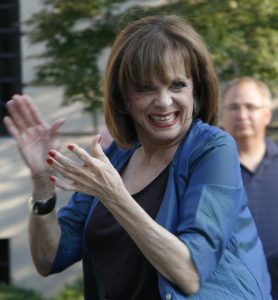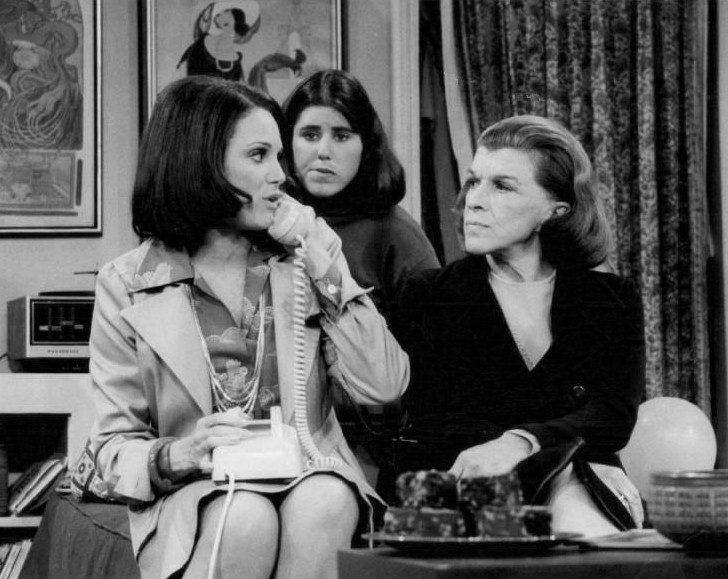|
Getting your Trinity Audio player ready...
|
 Actress Valerie Harper, who parlayed a sidekick role as the leading lady’s unapologetic best friend on “The Mary Tyler Moore Show” into her own hit sitcom with “Rhoda,” died on Friday, Aug. 30, 2019. She was 80 years old.
Actress Valerie Harper, who parlayed a sidekick role as the leading lady’s unapologetic best friend on “The Mary Tyler Moore Show” into her own hit sitcom with “Rhoda,” died on Friday, Aug. 30, 2019. She was 80 years old.
Harper’s death was confirmed by her daughter, Cristina Cacciotti. She did not say where her mother died.
Tony Cacciotti, Harper’s husband, announced in July 2019, on Facebook, that he had decided not to move his wife into hospice care as her doctors recommended. Harper had leptomeningeal carcinomatosis. This disease causes cancer cells to invade the fluid-filled membrane surrounding the brain.
Harper worked as a theater actress regularly, though she was not well known when she auditioned for a new CBS sitcom starring Mary Tyler Moore. Moore played a Minneapolis associate news producer, and the embodiment of a new rising American breed – the single working woman.
The part Harper auditioned for was Moore’s upstairs neighbor, Rhoda Morgenstern. She was a weight-conscious, self-deprecating, wisecrackingly blunt Jewish expatriate from New York City, according to The New York Times. This character would serve as a foil for Moore’s prim, sweet-tempered, every-hair-in-place and emphatically non-Jewish Mary.
Rhoda was a window dresser. She was also envious of Mary’s good looks and her slender figure. At the time, Harper was terribly overweight. Rhoda was determined to assert herself in their friendship and with the telltale brass of a New Yorker, she rarely hesitated to tell Mary that every man that courted her was all wrong for her.
“The Mary Tyler Moore Show” premiered in September 1970. The two characters met in the opening moments of the first episode. Mary is moving into her apartment, and she encounters Rhoda climbing in through a window from a ledge. Rhoda had been washing the windows, thinking the apartment was going to be hers.
Mary says, “So you’re, uh, Rhoda?”
“Morgenstern, right.”
“And I’m Mary Richards.”
Rhoda says, “Hello. Get out of my apartment.”
In the middle of the episode, Mary tells Rhoda that she is a hard person to dislike. Rhoda responds, “I know what you mean. I’m having a hard time hating you too. We’ll both have to work on it.”
The chemistry between the two actresses was infectious. Harper became an audience favorite. She won an Emmy Award for best supporting actress in a comedy series three years in a row. As early as the second season of “The Mary Tyler Moore Show,” ideas of a spinoff show based on Rhoda began to surface. By Season Three, Harper had lost weight and became more glamorous. The new show became a reality after the fourth season.
“Rhoda” made its debut in 1974 and ran until 1978. The character moves back to New York City, and with her acknowledged flaws and insecurities, becomes an “everywoman” alternative to Mary Richard’s ideal American sweetheart. She re-engages with her family. She has a sister who has a weight and self-esteem issues, played by Julie Kavner. There is Ida, a quintessentially meddling Jewish mother, played by Nancy Walker, and Martin, the doting papa played by Harold Gould. Additionally, she finally finds a husband, Joe Gerard, played by David Groh.
Their wedding takes place in the middle of Season One with a special hour-long episode. The episode begins the morning of the ceremony. Rhoda is assuring her sister that there is a wedding in her future. Rhoda says, “Well, someday it’s going to happen for you, Brenda. You meet a wonderful guy, fall in love, decide to get married and be just as nauseous as I am right now.”
The wedding episode was heavily hyped and heavily watched. After the episode, The New York Times critic, Cyclops wrote:
“We have gathered together before, as a nation, in front of the TV set, usually in mourning (after an assassination), sometimes in fear (was seems imminent), occasionally in wonder (setting foot on the moon). But this time we got together as a nation, in anticipation and retrospection, to watch a marriage.”
“The ‘we’ cut across class, generational and ethnic lines. A felt need can be inferred and perhaps and affirmation. We may not be sure we know what we want for ourselves, but what we want for other people is a reasonable facsimile of what Rhoda got, and what Joe, her spouse, got, too – love, humor, generosity, commitment.”
That season, Harper won her fourth Emmy. This time it was for best lead actress in a comedy series. In Season 3, Joe and Rhoda split up and Rhoda completed the show through seasons four and five, as she began – single and spunky.
Valerie Kathryn Harper was born on Aug. 22, 1939, in Suffern, New York. She was 32 miles north of New York City. Her father Howard was a salesman, and her mother Iva was a nurse. Harper was not Jewish; her heritage was a mix of European and French Canadian.
When Harper was young, she moved frequently. They moved to Michigan, California, Jersey City and Oregon. She went to high school in Jersey City. When she was a teenager, Harper’s parents divorced. Her father’s second wife was an Italian-American who was the model for Rhoda.
At the age of 16, Harper landed a job with the corps de ballet at Radio City Music Hall. In 1974, in an interview with The New York Times Magazine, she said, “I always felt like a klutz next to those other skinny girls, as we twirled our adorable little parasols.”
From the corps de ballet, Harper moved onto theater. She worked chorus-line jobs in the pre-Broadway show of “Li’l Abner,” and three Broadway shows, including “Wildcat,” starring Lucille Ball, and “Subways Are for Sleeping,” both directed by Michael Kidd
Additionally, Harper studied acting. John Cassavetes was one of her teachers. She supported herself with odd jobs. She was even a hatcheck girl at Lutéce. In 1964, she met and married an actor from Chicago-based Second City troupe, Richard Schaal. Harper joined the company herself. She learned improvisation techniques from founder Paul Sills and his mother, acting coach Viola Spolin.
She was part of the Second City group that appeared on Broadway in the 1970 “Paul Sills’ Story Theater.” It was a comic adaptation of Grimm’s fairy tales. The show was laced with improv and ran for more than eight months. This was while Harper was taping the first season of “The Mary Tyler Moore Show.” There was an article about Harper in The New York Times that began, “The sexiest chick on Broadway has a regular job moonlighting as an overweight spinster on television.”
After “Rhoda,” Harper continued to work in television and the movies. She starred in her own series, “Valerie” in 1986 and 1987. She played the working mother of three sons with an often absent husband. However, after a salary dispute, producers killed her off the show via car accident, replaced her with Sandy Duncan, and renamed the show, “Valerie’s Family,” and later “The Hogan Family.” The show stayed on the air until 1991.
By Jeanette Smith
Sources:
The New York Times: Valerie Harper, Who Won Fame and Emmys as ‘Rhoda,’ Dies at 80
NBC News: TV legend Valerie Harper dies at 80
CBS News: Actress Valerie Harper Dies at 80
Featured Image by eBay item Courtesy of Wikimedia Commons – Public Domain License
Inline Image Courtesy of David’s Flickr Page – Creative Commons License



